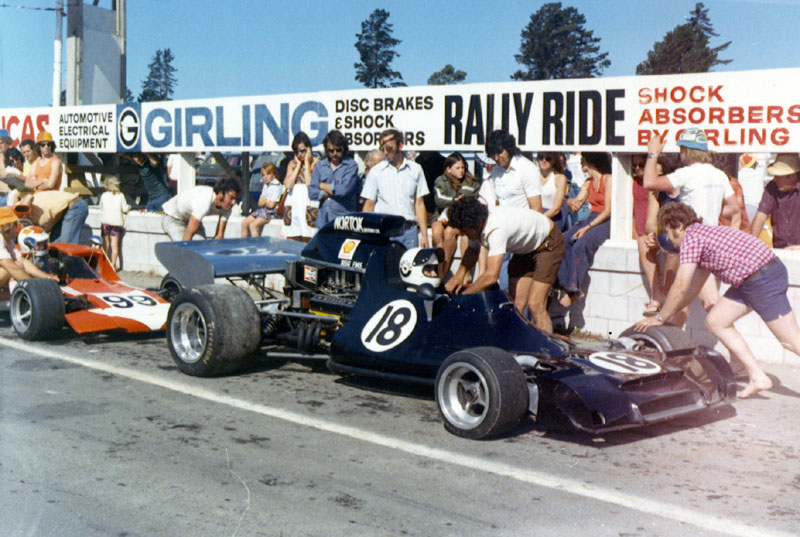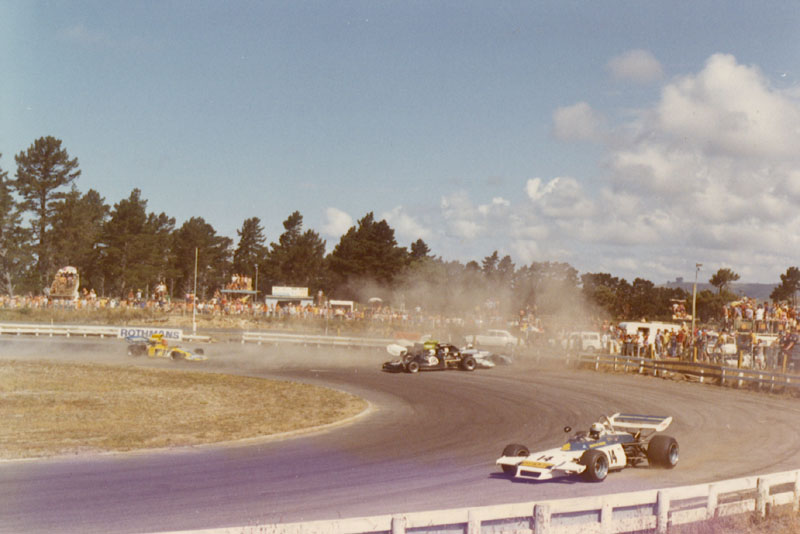-
Administrator


Sunday saw the running of the 40 lap International Trophy, combining the F1 and F5000 cars. Impressively, the top F5000 car of David Hobbs recorded a time that was faster than the previous years Formula 1 lap record, and would ultimately line up on the third row, in the 3-2-3 grid formation. The Begg team had no illusions of grandeur. Indeed, even in the impressive F5000 championship, which in 1973 was enjoying its most competitive season yet, they were realistic about their prospects.
Oxton started the International Trophy race in 24th, and struggled throughout the on tyres that were not suited to the icy conditions. However, he worked his way to 15th as the laps wore down. But so cold was it that with a handful of laps remaining, a snow shower struck the circuit, and Oxton went spearing off the track, with the car stalling and unable to re-join. Regardless of the outcome, the Begg team notched this up as a highly successful and enjoyable weekend.
Round 4 of the championship was held at Snetterton, and here Oxton and the Begg looked like genuine contenders. In changeable weather conditions, Oxton qualified fourth fastest. However, any chances of a good race result were scuppered immediately following the rolling start, when the Begg failed to accelerate with the rest of the field. After an initial stutter, the motor cleared. Oxton had lost several positions, but battled on to finish seventh.
Following the race the team went in search of the fault, eventually identifying a fuel pressure problem which starved the engine on acceleration. Once this was rectified, they took the car to Brands Hatch for some testing, with Oxton recording competitive times. Brands Hatch played host to Round 5, this being the big Easter weekend event which attracted a large entry.
Oxton spent the first portion of qualifying with a fuel pressure gauge taped to the side of the cockpit, so the team could be confident the fuel pressure problems had been rectified. Once they were sure, he set off again, and put his head down to set a fast time for the race. But immediately the heavens opened, and any chance of a good starting position was now impossible.
Come the race, and the bright yellow Begg would start from 14th on the grid. Worse still, heavy rain was falling, making driving treacherous, and visibility near impossible. After slithering around for the first few laps, Oxton was belting down the front straight when suddenly the Begg flicked into a spin after hitting a bump. It shot to the outer guard rail and proceeded to destroy itself as it made its way towards the first turn, still grinding along the guard rail. When eventually it came to rest, Oxton sprang from the smoldering wreck, lept several walls and fences, and eventually sat down in the safety of the nearest spectator grandstand.
Three weeks separated Brands Hatch from the next round at Oulton Park, and the team would use all that time to tear the car down and rebuild it. Virtually all the bolt-on components down the left side had been ripped off along the Brands guard rail, while the tub itself also suffered a small amount of damage. Upon reassembly, the bodywork would require a new coat of paint, and it was at this point the decision was made to switch from traditional Begg yellow, to black, in a desperate attempt to encourage a change of luck. But that was short-lived, as a front wishbone broke during qualifying, with Oxton fortunate not to wreck again. He qualified ninth with an unwieldy car, and in yet another wet race, finished in the same position.
Following Oulton Park, the team went testing at Silverstone, and clearly they made some significant improvements, for at the next round, held at Mallory Park, Oxton qualified third fastest. Come the race, and he held his starting position for much of the duration, until picking up a slow puncture from stones flicked up off the track. With the tyre deflating, Oxton continued to push, but lost two positions towards the end, finishing an eventual fifth. Luck had deserted the Begg team, but at least the speed was there.
The next round of the championship was held at the Misano circuit in Italy. The European F5000 Championship organisers contacted several of the teams offering travel expenses to Italy, the Begg team included. With a Ford Transit as tow vehicle, it took the small team of George Begg, David Oxton, and Joe Wright three days to reach Misano. In free practice, Oxton and the Begg were lapping quickly, recording one of the fastest times. However, in a bizarre decision, the local council decided the F5000 cars were too fast and dangerous for the track, and promptly cancelled their participation. At that, the Begg team loaded up and headed back to England.

Round 9 was due to be held at Zandvoort, in the Netherlands. However, this event was cancelled following pressure from Formula 1 teams claiming the F5000s could cause damage to the track, at which Round 10 of the F1 World Championship was due to be held four weeks later. Therefore, it was back at Mallory Park the F5000 teams assembled again next. For the Begg team, however, this was to be a shortened event, when the engine suffered a failure in qualifying, with no time to change it for the race.
Next up was Mondello Park, in Ireland, and Oxton struggled in qualifying, eventually lining up twelfth, albeit, just 8 tenths off pole position. The racing was contested over two heats, the first of which saw the Begg finished tenth. In Heat 2, rain fell just prior to the start, but the Begg team gambled on the track drying during the race, a gamble which paid off, with Oxton coming home in fifth.
 Posting Permissions
Posting Permissions
- You may not post new threads
- You may not post replies
- You may not post attachments
- You may not edit your posts
-
Forum Rules







 Reply With Quote
Reply With Quote